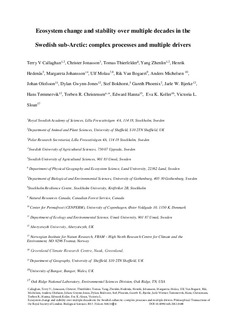Ecosystem change and stability over multiple decades in the Swedish subarctic: complex processes and multiple drivers
Callaghan, Terry V.; Jonasson, Christer; Thierfelder, Tomas; Yang, Zhenlin; Hedenås, Henrik; Johansson, Margareta; Molau, Ulf; Van Bogaert, Rik; Michelsen, Anders; Olofsson, Johan; Gwynn-Jones, Dylan; Bokhorst, Stef; Phoenix, Gareth K.; Bjerke, Jarle Werner; Tømmervik, Hans; Christensen, Torben R.; Hanna, Edward; Koller, Eva K.; Sloan, Victoria L.
Journal article, Peer reviewed
Accepted version

View/
Date
2013Metadata
Show full item recordCollections
- Publikasjoner fra CRIStin - NINA [2364]
- Scientific publications [1392]
Original version
10.1098/rstb.2012.0488Abstract
The subarctic environment of northernmost Sweden has changed over the past century, particularly elements of climate and cryosphere. This paper presents a unique geo-referenced record of environmental and ecosystem observations from the area since 1913. Abiotic changes have been substantial. Vegetation changes include not only increases in growth and range extension but also counterintuitive decreases, and stability: all three possible responses. Changes in species composition within the major plant communities have ranged between almost no changes to almost a 50 per cent increase in the number of species. Changes in plant species abundance also vary with particularly large increases in trees and shrubs (up to 600%). There has been an increase in abundance of aspen and large changes in other plant communities responding to wetland area increases resulting from permafrost thaw. Populations of herbivores have responded to varying management practices and climate regimes, particularly changing snow conditions. While it is difficult to generalize and scale-up the site-specific changes in ecosystems, this very site-specificity, combined with projections of change, is of immediate relevance to local stakeholders who need to adapt to new opportunities and to respond to challenges. Furthermore, the relatively small area and its unique datasets are a microcosm of the complexity of Arctic landscapes in transition that remains to be documented. subarctic environment, climate change impacts, ecosystem stability